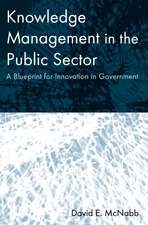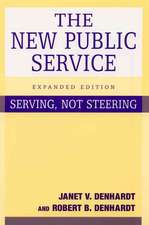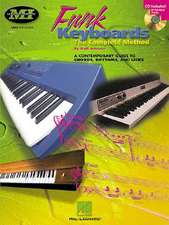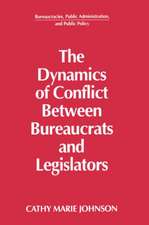Research Methods for Public Administrators: Third Edition
Autor Gail Johnsonen Limba Engleză Paperback – 30 mar 2014
As in previous editions, this highly practical book is written with beginning MPA students and practitioners in mind. It focuses on the interpretation and use of research findings, not just number crunching. It covers the entire research process, from initial questions to final report, in clear, jargon-free language, and includes numerous easy-to-understand examples and exercises that provide opportunities for concrete applications of the concepts. It is solidly grounded in public administration and recognizes both the promise and limitations of research within a political environment.
Key features of the book:
--It is highly practical and written to accommodate a mix of readers: those who want to become analysts, managers who will oversee research contracts, and citizens who need to know whether to believe the facts and data they read in today's news;
--It minimizes the use of jargon and explains difficult concepts in clear language. Plentiful end-of-chapter exercises provide opportunities for concrete application of the concepts;
--Key points are highlighted as "takeaway lessons" so readers are reminded about what really matters. The tough questions to ask are suggested in every chapter;
--Examples and applications are used throughout the book to illustrate concepts and add topical interest;
--It covers the entire research process, from initial questions to the final report.
This book demystifies and makes practical the research every public administrator and policy analyst needs to do the job well. Online instructor's materials, including a Test Bank, PowerPoint slides, and a Survey and Documental Analysis (SDA) guide, are also available to adopters.
| Toate formatele și edițiile | Preț | Express |
|---|---|---|
| Paperback (1) | 369.65 lei 6-8 săpt. | |
| Taylor & Francis – 30 mar 2014 | 369.65 lei 6-8 săpt. | |
| Hardback (1) | 438.41 lei 6-8 săpt. | |
| Bloomsbury Publishing – 29 mai 2002 | 438.41 lei 6-8 săpt. |
Preț: 369.65 lei
Preț vechi: 464.07 lei
-20% Nou
70.73€ • 75.64$ • 58.98£
Carte tipărită la comandă
Livrare economică 18 aprilie-02 mai
Specificații
ISBN-10: 0765637146
Pagini: 350
Ilustrații: black & white illustrations, black & white tables
Dimensiuni: 191 x 235 x 20 mm
Greutate: 1.35 kg
Ediția:3 Rev ed.
Editura: Taylor & Francis
Colecția Routledge
Locul publicării:Oxford, United Kingdom
Public țintă
Postgraduate, Professional, and UndergraduateCuprins
Preface and Acknowledgments
1. Introduction: Research Methods for Public Administrators
Overview Goals: Research as a Critical Thinking Tool Research in the Public Sector What Is Research? Types of Research Ethics and Principles of Good Research
Overview of This Book
Exercises
2. Basic Research Concepts
Overview
The Secret Language of Social Science Theory Hypothesis in Its Many Forms Variables Values Levels of Measurement Determining Causality Independent and Dependent Variables Control Variables Direction of Relationships Program Evaluation: Research in the Public Sector
Using Models for a Holistic View of Relationships
The Logic Model
Applying the Logic Model
Conclusion
Exercises
3. What Is the Question?
Overview
Determining the Research Question
Learning from Others
Engaging the Stakeholders
Working Together
Types of Questions Descriptive Questions Normative Questions Relationship Questions Conclusion
Exercises
4. Identifying Measures and Measurement Strategy
Overview
Defining Key Terms Conceptual Definitions Operational Definitions Setting Boundaries
Valid and Reliable Measures Validity Reliability Why Measurement Matters
Conclusion
Exercises
5. Designs for Research: The Xs and Os Framework
Overview
Designing an Experiment
Applying the Design Elements: The Xs and Os Framework Nonexperimental Design Quasi-Experimental Design Classic Experimental Design Design Variations Using Statistical Controls to Create Comparison Groups Longitudinal Studies Internal Validity
Why Validity Matters
External Validity
Conclusion
Exercises
6. Other Research Approaches
Overview
Secondary Analysis of Data
Evaluation Synthesis (Meta-Analysis)
Content Analysis
Survey Research
Case Studies
Cost-Benefit Analysis
Conclusion
Exercises
7. Data Collection I: Available Data and Observation
Overview
Data Collection: The Degree of Structure
Available Data
Data Collection Instruments
Observation
Obtrusive and Unobtrusive Data Collection
The Design Matrix
Conclusion
Exercises
8. Data Collection II: Interviews and Focus Groups
Overview
General Guidelines About Choosing the Appropriate Method
Encouraging Participation
In-Person Interviews
Focus Groups
Other Group Data Collection: Expert Panels, Public Hearings
Conclusion
Exercises
9. Data Collection III: Surveys
Overview
Basic Methods
Response Rates
Telephone Surveys
Mail Surveys
Cyber-Research: E-mail and Web-Based Surveys
Developing Closed-Ended Questions
Using One-Way and Two-Way Intensity Scales
Ranking Questions
Demographic Questions
Conclusion
Exercises
10. Sampling Demystified
Overview
Sampling Jargon
Random and Nonrandom Samples Random Samples Nonrandom Samples Random Samples: The Options Simple Random Sample Systematic Random Sample Stratified Random Sample Proportional Stratified Sample Disproportionate Stratified Sample Cluster Sample Nonrandom Samples: The Options
Determining Sample Size
Nonsampling Errors
Conclusion
Exercises
11. Qualitative Data Analysis
Overview
Analyzing Qualitative Data
Identifying Themes and Quotes
Working with Qualitative Data
Conclusion
Exercises
12. Data Analysis for Description
Overview
Simple Descriptive Statistics in Public Administration
Commonly Used Descriptive Statistics Counts Percents Rates Ratios Rates of Change Distributions Measures of Central Tendency Which Measure to Use? Comparison of Means Measures of Dispersion
Conclusion
Exercises
13. Analyzing Survey Scales
Overview
Handling Exits and the Middle of a Five-Point Scale
Setting Benchmarks and Extreme Analysis
Handling the Middle Category in One-Way Intensity Scales
Should Means Be Used with Nominal and Ordinal Scales?
The Analytical Tool: Cross Tabulations
Conclusion
Exercises
14. Data Analysis: Exploring Relationships
Overview
Using Crosstabs to Examine Relationships
Controlling for a Third Variable
Exploring Relationships: Comparison of Means and Medians
Measures of Association
Frequently Used Measures of Association
Working with Interval or Ratio Data
Conclusion
Exercises
15. Data Analysis: Regression
Overview
Bivariate Regression: Key Elements
Using Bivariate Regression Analysis: Sunshine and Tourism
Multiple Regression Beta Weights: Relative Predictive Strength Regression in the News
Why Did the Violent Crime Rate Drop After 1991?
Conclusion
Exercises
16. Data Analysis Using Inferential Statistics
Overview
Statistical Significance: Basic Concepts
The Logic of Statistical Significance Testing
Errors in Tests for Statistical Significance
Common Tests for Statistical Significance Chi-Square t-Tests: Analyzing Difference in Means Analysis of Variance Tests for Statistical Significance in Regression Analysis
Reporting Results of Statistical Significance
Population Estimates and Confidence Intervals
Conclusion
Exercises
17. Communicating Research Results
Overview
Effectively Reporting Results
Reporting Data
General Guide for Communicating Research Results
Guide for Writing an Executive Summary
Guide for Writing a Formal Report
Guide for Using Charts and Tables
Guide for Oral Presentations
Presenting Unwelcome Information
Making Sense of Research Results
Conclusion
Exercises
18. Conclusion: Research at the Intersection of Politics and Administration
Overview
The Research Process Revisited Planning Doing Reporting Ethics and Social Justice
Managing Research Projects
Assessing Credibility
The Limitations of Science
The Intersection of Research, Politics, and Administration
Closing Observations
Exercises
Appendix A. Mathematical Formulas for Selected Statistics
Appendix B. Statistics as a Second Language
Appendix C. Bibliography
Appendix D. Logic Model Template
Appendix E. The Generic Design Matrix
Index
About the Author
Recenzii
"Research Methods for Public Administrators is extremely remarkable as it treats both qualitative and quantitative research methods in a comprehensive manner without compromising clarity and readability. The rare combination of broad coverage and reader-friendliness really makes this book an excellent resource for students learning basic research tools." -- Chih-Wei Hsieh, University of New Mexico
"Finally we have an approachable methods book. Gail Johnson's practitioner background helps her to discuss a very complex topic, research methods, in an understandable and practical manner. While covering the basics of research design and statistics, she also gives attention to the important topic of communicating research findings. Additionally, Johnson ties research methods to its uses in the public sector. This book is well suited for a variety of public administration programs, but it is particularly useful for those with many in-service students." -- Jami Taylor, University of Toledo
"This is the consummate methods survey text for public administration and policy study, somehow improved in the new edition over already superlative previous ones. In the new edition, conceptual frames continue to be covered with even greater nuance and depth--topics such as policy and program complexity, complex causation, logic modeling, the inter-relation of normative and descriptive/empirical questions in public sector research, research ethics, and the refinement of research questions in these contexts, for instance translating research questions into hypotheses. Most highly recommended!" -- Mario Rivera, University of New Mexico
"This textbook offers a comprehensive yet understandable overview of the process of research and its use in the field of public administration. The author's focus on how to use and interpret research findings is a welcome addition to the topic and the real-world exercises provide students with practical application of research skills essential for public managers. A great textbook for MPA students!" -- Pamela T. Dunning, Troy University
Notă biografică
Gail Johnson has worked in several public agencies, including the U.S. Government Accountability Office and the U.S. Department of Health and Human Services. Her work with GAO included reports about management of federal agencies, transforming the civil service, and drug use among youth. She has taught in MPA programs for more than fifteen years, worked as consultant with several local governments, and helped design several research workshops for The World Bank. She recently published "Trailblazing Governors: Six Remarkable Women," which tells the stories of six of the first generation of women governors. She maintains a blog, Research Demystified, which explores social science research in the context of politics, policy, public administration, program evaluation, and measuring for results and advocacy.
Descriere
As in previous editions, this highly practical book is written with beginning MPA students and practitioners in mind. It focuses on the interpretation and use of research findings, not just number crunching. It covers the entire research process, from initial questions to final report, in clear, jargon-free language, and includes numerous easy-to-understand examples and exercises that provide opportunities for concrete applications of the concepts. It is solidly grounded in public administration and recognizes both the promise and limitations of research within a political environment.
Key features of the book:
--It is highly practical and written to accommodate a mix of readers: those who want to become analysts, managers who will oversee research contracts, and citizens who need to know whether to believe the facts and data they read in today's news;
--It minimizes the use of jargon and explains difficult concepts in clear language. Plentiful end-of-chapter exercises provide opportunities for concrete application of the concepts;
--Key points are highlighted as "takeaway lessons" so readers are reminded about what really matters. The tough questions to ask are suggested in every chapter;
--Examples and applications are used throughout the book to illustrate concepts and add topical interest;
--It covers the entire research process, from initial questions to the final report.
This book demystifies and makes practical the research every public administrator and policy analyst needs to do the job well. Online instructor's materials, including a Test Bank, PowerPoint slides, and a Survey and Documental Analysis (SDA) guide, are also available to adopters.
















